| Home: Global Wood | Industry News & Markets |
| Home: Global Wood | Industry News & Markets |
Japan Wood Products Prices |
||||||||||||||||||||||||||||||||||
Japan Wood Products Prices Dollar Exchange Rates of 10th May 2013 Japan Yen 101.60 Reports From Japan
Consumer confidence unexpectedly slides
At the recent G7 meeting of representatives from members - the U.S., Germany, France, Italy, Japan, Canada and the U.K steered clear of discussions of ‘currency wars’ instead focused on how each member should put in place policies balancing austerity measures with growth-enhancing measures.
Meantime, in units built for sale, condominium starts were down because of high starts in February but detached units increased for seven consecutive months and maintained more than 10,000 units level since last June.
Movement of plywood is getting stable after excitement is fading. Inquiries in domestic softwood plywood are slowing by dealers. In the first quarter, wholesalers and retailers built up inventories in speculation but actual demand did not appear as expected so the inventory depletion is not progressing.
On imported plywood, supplying mills suffer log shortage and high log cost in Malaysia and Indonesia so that export prices continue climbing but the market in Japan is slow to follow by lack of demand. Dealers’ inventories are still high so that they are not able to buy future cargoes.
In Tokyo market, the prices of 3x6 JAS concrete forming panel are 1,100 yen per sheet delivered, 20 yen up from April. 12 mm structural panel are 1,150 yen, 50 yen up. JAS 3x6 coated concrete forming panel are1,200 yen, 20 yen up.
|
||||||||||||||||||||||||||||||||||
|
||||||||||||||||||||||||||||||||||
Source: ITTO' Tropical Timber Market Report |
CopyRight (C) Global Wood Trade Network. All rights
reserved.
hief minister of Tamil Nadu Ms.Jayalalithaa, has announced the establishment of a Rs.12 billion project for the annual manufacture of 200,000 tonnes of multi-layer double coated packaging board.
This new plant will be built in Tiruchi by Tamil Nadu Newsprint and Papers
Ltd and is expected to provide additional employment for 2,000 people. At
present around 40% of the demand for coated paper is met through imports.
The new plant will produce high end white liner boards for folding boxes,
the fastest growing segment in the paper industry.
The company is producing 400,000 tonnes of printing and writing papers and
has recently started a 600 tonnes per day cement plant using paper mill
waste and fly ash as raw material.
Scouting raw materials in Myanmar and Vietnam
To meet the rising demand for quality paper across India JK Paper is looking
to develop new facilities in Myanmar and Vietnam to source pulp so as to
increase output.
The company recognizes that in the short to medium term at least sourcing
domestic wood raw materials will remain a challenge. Because of this the
company says it is imperative to find new sources of quality raw materials.
The focus on Myanmar and Vietnam is due to their proximity and also their
policies for attracting inward investment.
The demand in India for paper continues to be strong. It is estimated at
around 11.5 million tonnes is currently required to meet domestic demand and
this could grow to 20 million tonnes by 2020.
The company has added close to 290,000 tonnes of production capacity over
the last few years and its total production capacity stands at 455,000
tonnes at the moment.
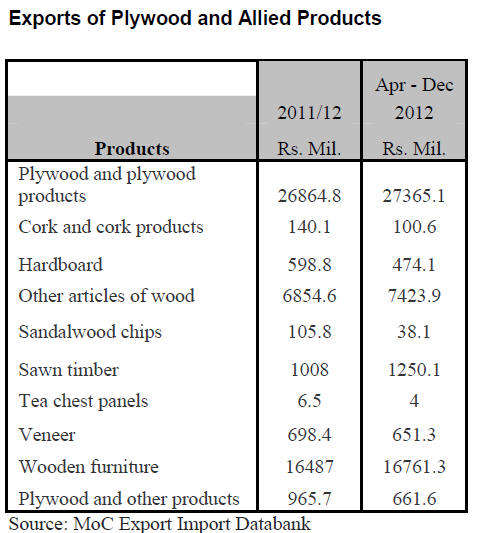
Sales of teak and other hardwoods at Western
forest Depots
During the last two to three auctions in south Gujarat depots the quality as
well as quantity of logs offered for sale were very good such that prices
improved on the back of strong buyer interest.
During the most recent auction a correction in prices was observed as buyers
limited purchases to their immediate requirements only.
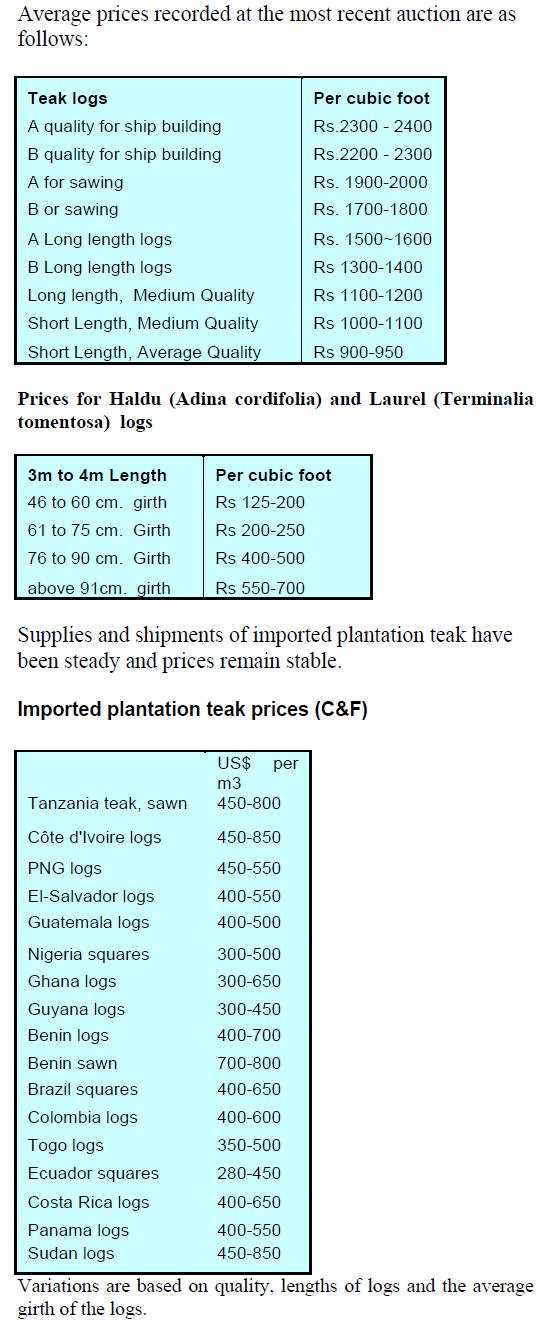
Ex-sawmill prices for imported hardwoods
Prices for air dried sawnwood per cubic foot, ex-sawmill are shown below.
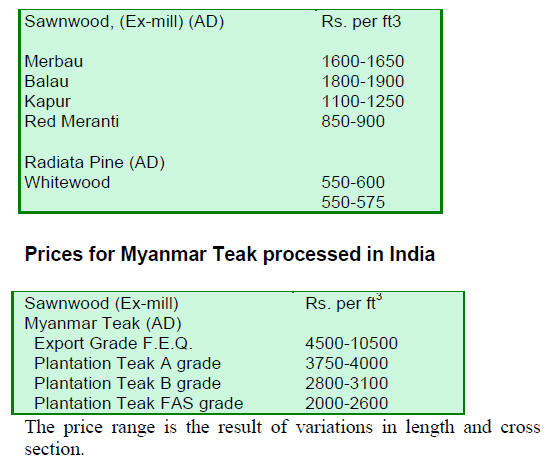
Imported KD 12% sawn wood
Prices are currently firm due to weak rupee.
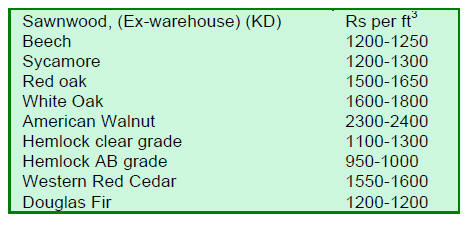
Plywood market prices
Prices remain unchanged as follows:

7. BRAZIL
Forest inventory to be updated by
2016
The first national forest inventory in Brazil was conducted in the 1980s and
the focus was on assessing timber stocks. A new inventory is planned and
will be broader in scope encompassing sustainability.
Work on testing the methodology for the new inventory started in Santa
Catarina and Brasilia in 2011 and full scale field work will begin this year
and will be completed by 2016.
The new inventory will provide authorities with more information enabling
them to plan and implement appropriate policies in areas such as forest
concession allocation and management and carbon stock assessments.
The inventory is expected to provide a greater knowledge of the potential of
the forests which represent about 62% of the 8.5 million square kilometers
of the country.
The new forest inventory will not only provide information for developing
conservation and environmental strategies but will also provide the means
for developing sound economic strategies for the sustainable management from
natural forest to ensure only legally sourced wood products enter the
domestic market.
The new forest inventory will be based on some 20,000 data points across the
country, 7,000 of which will be in the Amazon rainforest. The intention is
to update this new inventory every five years.
The cost of the new inventory is estimated at R$150 million, of which some
R$65 million will be provided from the Amazon Fund administered by the
Brazilian Development Bank.
São Paulo the largest domestic market for certified timber
The Institute of Agricultural and Forestry Management and Certification has
released a report on the consumption of certified Amazon timber entitled
"Unraveling the Brazilian market for FSC certified tropical timber".
The report addresses three main issues:
the relationship between producers and buyers of FSC certified wood
market opportunities for FSC certified wood
demand for products with the FSC community label
The report is based on interviews with companies and communities managing
forests as well as wood product manufacturers utilising timber from the
Amazon.
Brazil has a massive area of certified forest and is ranked the world’s
sixth largest in terms of certified forest.
The report mentions that the area of certified forest in Brazil amounts to
some 6.3 million hectares a figure which includes natural forests and forest
plantations.
The report further states that the share of certified natural forests is
approximately 20% of the total area of certified forest.
The report notes that around 70% of the available FSC certified timber is
exported but that a large volume of tropical timber sold in the domestic
market does not meet the social and environmental requirements of FSC
certification. São Paulo state is the largest national consumer of certified
timber (14%), followed by the Northeast region (9%).
The study highlights the potential for an increase in production of
certified tropical timber and estimates that output could grow by aabout 70%
over the next three years.
Developments in wood product exports
Between 2002 and 2012 wood product exports increased from US$3.8 billion to
US$8.5 billion however, exports of solid wood products, as a proportion of
the total, fell from 46% to 22% in the same period.
Between 2005 and 2012 plywood exports declined 87%, tropical sawnwood
exports declined 67% while exports of pine sawnwood fell 49%.
Other solid wood products exports also fell in the period 2005 to 2012 for
example, pine plywood exports were down by a third; there was also a 38%
reduction in exports of value-added products mainly furniture.
Data indicate that tropical timber exports were affected greater than
products from plantations.
Analysts suggest that the cause of the decline in tropical timber product
export was related to the increased costs involved in meeting more demanding
standards for forestry operations, the lack of a clear development policy
for the tropical wood products sector and environmental issues in importing
markets. These factors also resulted in a decline in investment in tropical
wood product manufacturing.
Another factor which contributed to the weaker exports was the strengthening
of the Brazilian currency such that Brazilian exporters lost competitiveness
in international markets.
Pará state to have new organization to monitor forest and milling
operations
To meet the requirement of the EU timber regulation European importers are
requesting documentation to prove the origin of wood products and
demonstrate legality throughout the supply chains.
This is a challenge for Brazilian exporters who say meeting the requirements
of imports in Europe is complex and requires Brazilian companies and
government institutions to work together to ensure trade is uninterrupted.
In the state of Pará, the biggest exporter of tropical timber in Brazil,
measures to improve monitoring and reporting of forest and processing
operations are being considered. Media reports suggest it is possible a new
organization will be established to provide monitoring services to industry.
It is estimated that the current forest concessions which were allocated
after 2010 can supply between 14 and 20 million cubic metres of which 85%
will be consumed in the domestic market and the remainder exported.
Analysts report that the pulp and paper sector has been able to adjust
quickly to the requirements of the EUTR as most operators were producing
certified products and had management processes in place which could be
adapted to meet the requirements of importers in Europe.
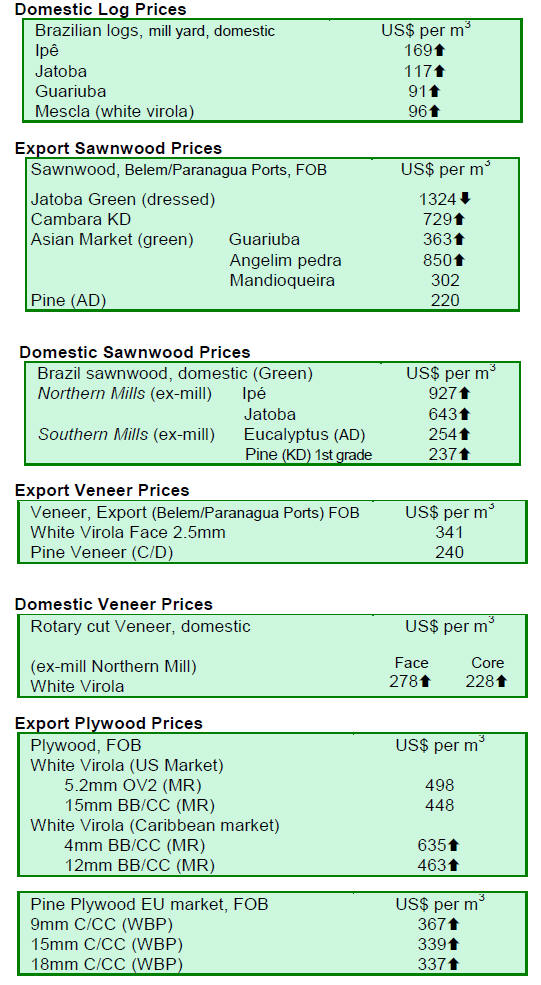
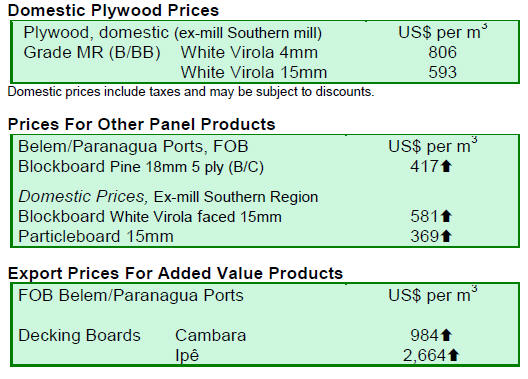
8. PERU
Industrial park planned for Pucallpa
In August this year work will begin on the construction of an industrial
park in Pucallpa. The park will be adjacent to the Federico Basadre road,
which runs from Pucallpa to Lima.
When complete the industrial park will extend over 288 hectares. The first
phase of the development will involve 44 hectares and will cost around US$12
million. Finance will be provided by the Development Finance Corporation (COFIDE).
The relocation of wood processing plants to the park is expected to
facilitate greater control over the flow of logs. All logs coming from
Loreto and Ucayali will enter the park making the monitoring and control of
log movements more efficient.
The concentration of processing plants in the park will also provide an
opportunity for efficient wood residue utilisation and disposal.
Native communities contribute to National Forest and Wildlife Policy
The Association for the Development of the Peruvian Rainforest (AIDESEP), an
organization that brings together native communities from around the
country, has contributed to the draft National Forestry and Wildlife Policy
(PNFFS).
During a recent workshop to discuss the Forestry and Wildlife Policy draft
Alberto Pizango Chota, president of the AIDESEP, highlighted the importance
of open and honest communication between indigenous peoples and the state.
The workshop concluded with approval of the contributions from AIDESEP.

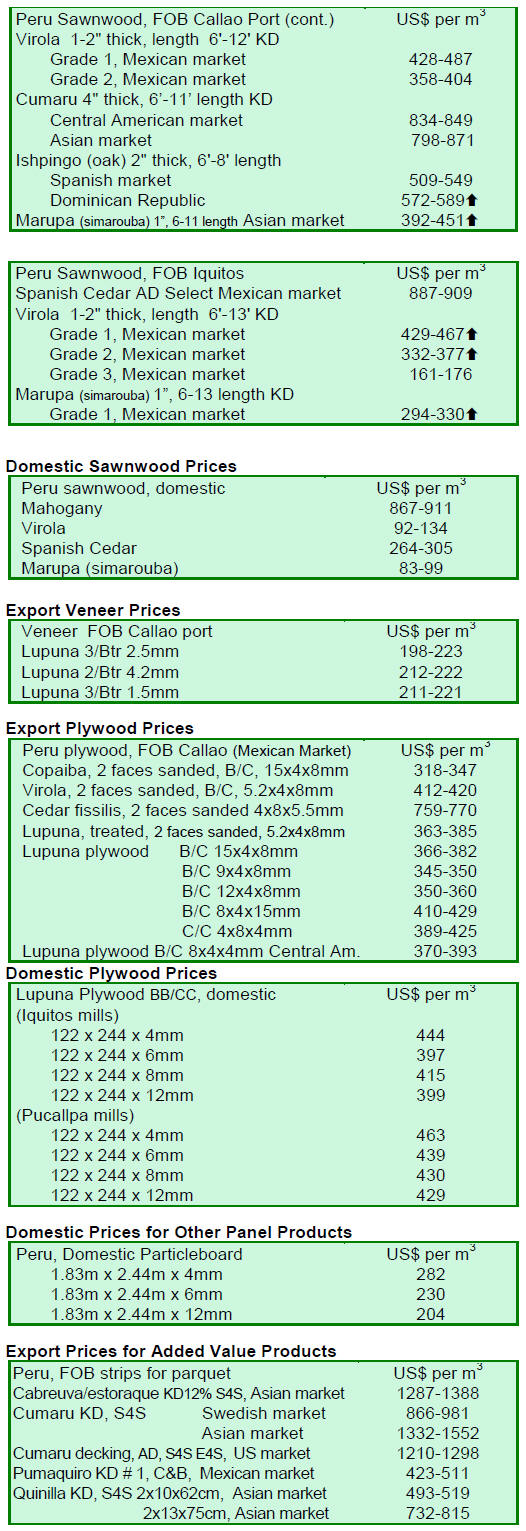
9. GUYANA
India a major market for Guyana logs
For almost a month there has been no export of greenheart logs however,
purpleheart logs were exported in both Standard and Fair sawmill qualities.
Purpleheart standard quality log FOB prices remain largely unchanged at
US$385 per cubic metre while FOB prices for Fair sawmill quality logs were
at US$300 per cubic metre.
Mora logs were exported in the period under review and prices firmed
slightly. Both Standard and Small sawmill quality logs were exported at an
average of US$135 per cubic metre. The main market for logs for the period
of review was India.
Firm demand spurs improved prices
The export market for sawnwood was active and favourable prices were
secured.
Undressed greenheart sawnwood was traded at prices ranging from US$636 to
US$975 per cubic metre FOB.
Undressed purpleheart (select) sawnwood say top end prices move from US$950
to US$1,100 per cubic metre FOB. On the other hand Undressed purpleheart
(merchantable) sawnwood prices remained stable at US$650 per cubic metre
FOB.
Undressed mora (select) sawnwood export FOB prices also recorded gains,
moving from US$575 to US$595 per cubic metre.
Undressed mora (merchantable) also attracted favourable prices earning as
much as US$615 per cubic metre FOB.
Dressed greenheart sawnwood export prices improved from US$1,102 just two
weeks ago to US$1,166 per cubic metre FOB, but Dressed purpleheart sawnwood
prices remained unchanged at US$1,102 per cubic metre FOB.
Plywood export FOB prices were largely unchanged at US$584 per cubic metre.
Roundwood (Piles and Posts) attracted favourable prices on the export
market. Greenheart Piles earned as much US$634 per cubic metre with main
market being North America. Posts also secured favourable prices on the
export market with US$530 per cubic metre.
Primary and value added industries to benefit from development
initiatives
The forest industry recorded a stable performance in 2012 in comparison to
2011. The Guyana Forestry Commission is working with operators to encourage
optimal utilisation of the forest and to widen the range of species
harvested.
A number of initiatives are being undertaken by Government of Guyana and the
Guyana Forestry Commission to improve the performance of the sector at the
primary and value added levels. In addition a number of other initiatives in
the area of sustainable forestry management, REDD+ and climate change will
continue during 2013.
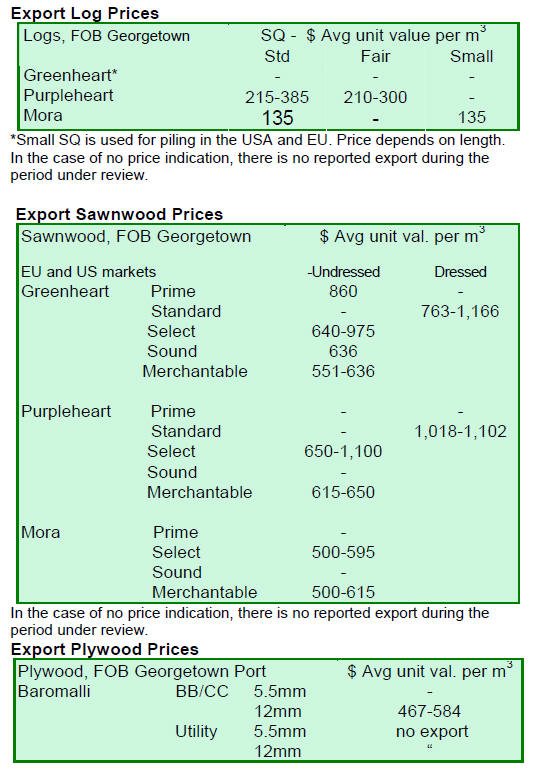
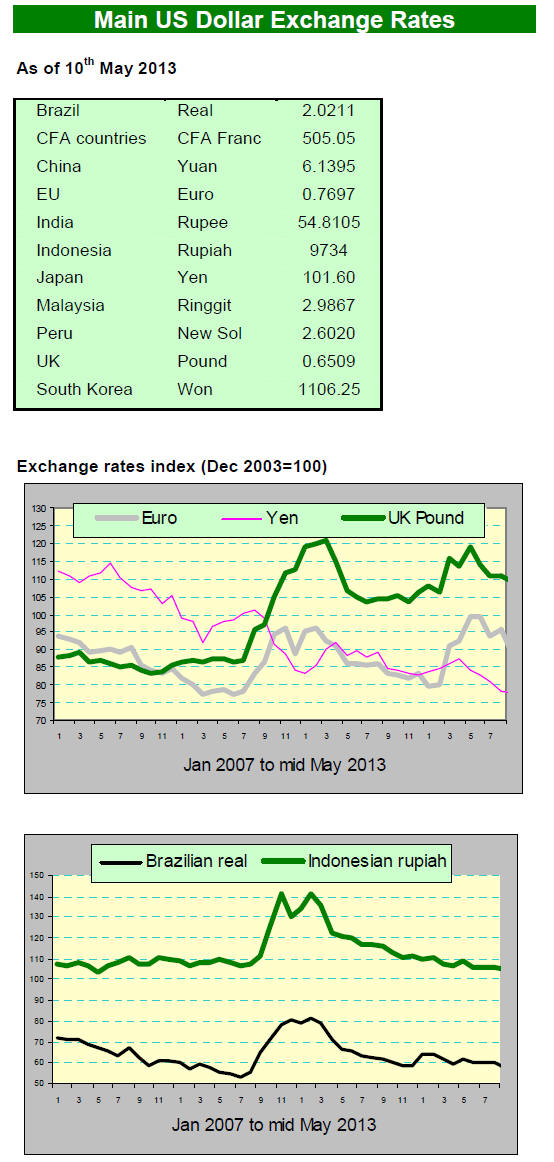
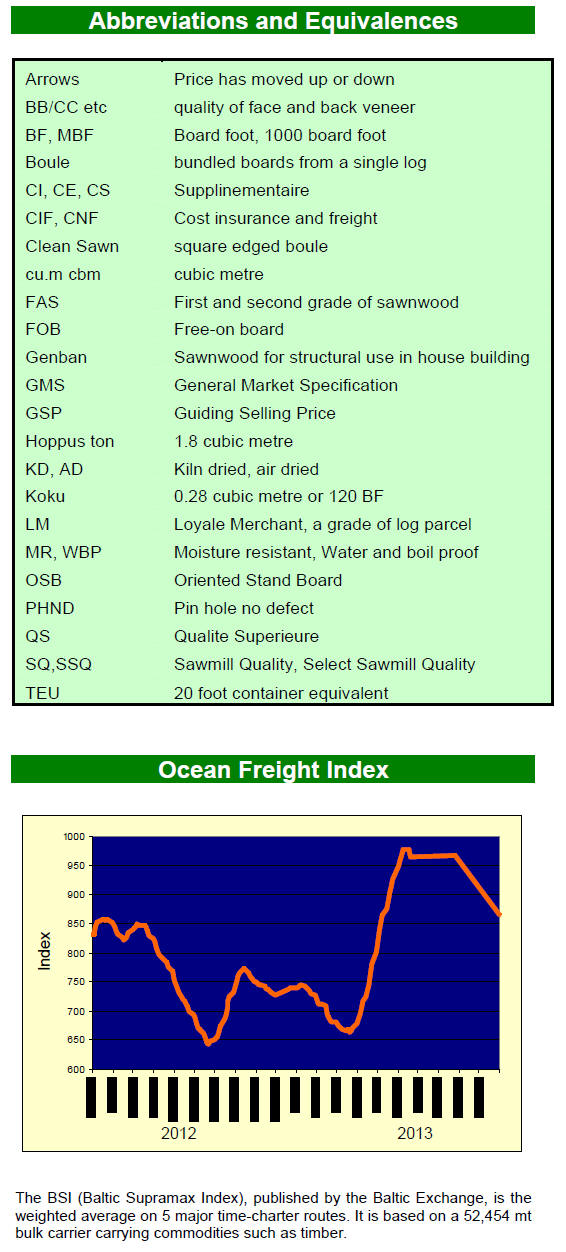
Source:ITTO' Tropical Timber Market Report
CopyRight(C) Global Wood Trade Network. All
rights reserved.